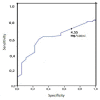Value of twelfth hour bilirubin level in predicting significant hyperbilirubinemia in preterm infants
- PMID: 24734145
- PMCID: PMC3985561
- DOI: 10.14740/jocmr1639w
Value of twelfth hour bilirubin level in predicting significant hyperbilirubinemia in preterm infants
Abstract
Background: As hyperbilirubinemia is a significant cause of brain injury, it is important to predict the cases who are at risk. Data for preterm infants are scarce. The aim of this study is to predict significant hyperbilirubinemia in preterm infants by measuring capillary bilirubin at 12th hour of life.
Methods: One hundred and fifty neonates born ≤ 35 weeks were included in the study. They were categorized into two groups according to their birth weights (group 1: 1,000 - 1,499 g; group 2: 1,500 - 2,000 g). Their bilirubin levels were measured at 12th hour and daily thereafter for 5 days. Risk nomograms were generated based on their bilirubin measurements and postnatal ages. On the age-specific percentile-based nomogram, the zone above the 90th percentile was determined as high risk and those below the fifth percentile as low risk. Infants who had bilirubin levels over the limits defined according to their postnatal ages and birth weights were accepted to have significant hyperbilirubinemia and received phototherapy and predictive value of the 12th hour bilirubin was asssessed.
Results: Fifty-four of 57 infants (94.7%) in group 1 and 75/93 infants (80.7%) in group 2 received phototherapy. Capillary bilirubin levels of 3.55 mg/dL and 4.55 mg/dL for group 1 and group 2 measured at the 12th hour of life had the highest sensitivity, negative and positive predictive value to predict the neonates who will develop significant hyperbilirubinemia.
Conclusion: Bilirubin levels of preterm infants should be monitored closely. More attention should be paid to the ones who had 12th hour bilirubin level above the cutoff values.
Keywords: Hyperbilirubinemia; Neonate; Phototherapy; Preterm.
Figures



Similar articles
-
An early (sixth-hour) serum bilirubin measurement is useful in predicting the development of significant hyperbilirubinemia and severe ABO hemolytic disease in a selective high-risk population of newborns with ABO incompatibility.Pediatrics. 2002 Apr;109(4):e53. doi: 10.1542/peds.109.4.e53. Pediatrics. 2002. PMID: 11927726 Clinical Trial.
-
Incidence, course, and prediction of hyperbilirubinemia in near-term and term newborns.Pediatrics. 2004 Apr;113(4):775-80. doi: 10.1542/peds.113.4.775. Pediatrics. 2004. PMID: 15060227
-
Bilirubin nomogram for prediction of significant hyperbilirubinemia in north Indian neonates.Indian Pediatr. 2013 Apr;50(4):383-9. doi: 10.1007/s13312-013-0119-8. Epub 2012 Oct 5. Indian Pediatr. 2013. PMID: 23255694
-
Prevention of bilirubin encephalopathy.Biol Neonate. 2001;79(3-4):219-23. doi: 10.1159/000047095. Biol Neonate. 2001. PMID: 11275655 Review.
-
Cochrane Review: Prophylactic phototherapy for preventing jaundice in preterm or low birth weight infants.Evid Based Child Health. 2013 Jan;8(1):204-49. doi: 10.1002/ebch.1898. Evid Based Child Health. 2013. PMID: 23878128 Review.
Cited by
-
Rate of rise of total serum bilirubin in very low birth weight preterm infants.Pediatr Res. 2020 May;87(6):1039-1044. doi: 10.1038/s41390-019-0415-7. Epub 2019 May 13. Pediatr Res. 2020. PMID: 31086285
References
-
- Knupfer M, Pulzer F, Gebauer C, Robel-Tillig E, Vogtmann C. Predictive value of umbilical cord blood bilirubin for postnatal hyperbilirubinaemia. Acta Paediatr. 2005;94(5):581–587. - PubMed
-
- Seidman DS, Ergaz Z, Paz I, Laor A, Revel-Vilk S, Stevenson DK, Gale R. Predicting the risk of jaundice in full-term healthy newborns: a prospective population-based study. J Perinatol. 1999;19(8 Pt 1):564–567. - PubMed
-
- American Academy of Pediatrics Subcommittee on H. Management of hyperbilirubinemia in the newborn infant 35 or more weeks of gestation. Pediatrics. 2004;114(1):297–316. - PubMed
-
- Stevenson DK, Fanaroff AA, Maisels MJ, Young BW, Wong RJ, Vreman HJ, MacMahon JR. et al. Prediction of hyperbilirubinemia in near-term and term infants. Pediatrics. 2001;108(1):31–39. - PubMed
-
- Newman TB, Liljestrand P, Escobar GJ. Jaundice noted in the first 24 hours after birth in a managed care organization. Arch Pediatr Adolesc Med. 2002;156(12):1244–1250. - PubMed
LinkOut - more resources
Full Text Sources
Other Literature Sources
Research Materials
